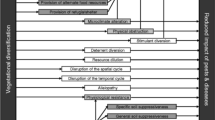Abstract
In northwestern Portugal, peasants have developed complex vineyard (Vitis vinifera) systems comprising agroforests composed of host trees, vines, annual crops and in some cases animals. Until recently these vineyards suffered very few pest problems and received relatively low pesticide loads. In the last few years, new policy and market forces have prompted the conversion of many of these systems to monoculture thereby decreasing the biodiversity inherent to traditional vineyards. Many scientists are concerned that with accelerating rates of vineyard simplification insect pest and disease problems may increase due to lack of habitat and resources for natural enemies or to a concentration of preferred host plants for specific pathogens and herbivores. During the growing seasons of 1997 and 1999 we conducted several farm surveys of traditional agroforestry and modernized, monoculture farms. We conducted field measurements to elucidate trends in insect pest and disease incidence in both types of vineyards. Our surveys revealed that monoculture vineyards exhibited lower number of species of predators and parasites and correspondingly higher densities of two grape herbivores (Lobesia botrana and Empoasca vitis) than diverse vineyard agroforests. Botrytis bunch rot seemed more prevalent in the monoculture systems, which also received increased fungicide applications when compared to the traditional vineyards. Although preliminary, our studies suggest that new vineyard designs may be more productive, but such gains occur at the expense of biodiversity and agricultural sustainability, reflected on higher pest vulnerability. Further agroecological studies are needed to account for the full ecological costs of the modernization of traditional vineyard agroforests.
Similar content being viewed by others
References
Altieri M.A. 1994. Biodiversity and Pest Management in Agroecosystems. Harworth Press, New York, 185 pp.
Avillez F., Jorge M., Jesus J. and Trimdale C. 1992. Small farms in northern and central Portugal. In: Monke E., Avillez F. and Pearson S. (eds), Small Farm Agriculture in Southern Europe. Ashgate, Aldershot, UK, pp. 55-72.
Cavalloro R. 1989. Influence of Environmental Factors on the Control of Grape Pests, Diseases and Weeds. A.A. Balkeme, Rotterdam, 351 pp.
Coley-Smith J.R. 1980. The Biology of Botrytis. Academis Press, London, 318 pp.
Jones D.G. 1998. The Epidemiology of Plant Diseases. Kluwer Academic Publications, Dordrecht, 460 pp.
Magurran A.E. 1988. Ecological Diversity and its Measurement. Princeton University Press, Princeton, 167 pp.
Pearson S.R., Avillez F., Bentley J.W. and Finan T.J. 1987. Portuguese Agriculture in Transition. Cornell University Press, Ithaca, 283 pp.
Pedigo L.P. and Bunton G.D. (eds) 1994. Handbook for Sampling Methods of Arthropods in Agriculture. CRC Press, Boca Raton, Florida, 340 pp.
Pielou E.C. 1969. An Introduction to Mathematical Ecology. Wiley Interscience, New York, 286 pp.
Quartau J.A., Fancony A.I. and Andre G. 1989. Jacobiasa lybica,a New Leafhopper Infesting Vineyards in Southern Portugal. Bol Soc Port De Entomologia 114: 124-133.
Raposo M.E. and Amaro P. 1997. Cultural Practices and Insect Pest Management in Vineyards. Actos de Horticultura (Port.) 18: 171-177.
Roehrich R. and Boller F. 1991. Tortricids in vineyards. In: Grant V. (ed.), Tortricid Pests, Their Biology, Natural Enemies and Control. Springer-Verlag, The Netherlands, pp. 51-62.
Ruiz Castro A. 1950. La Lucha Contra las Plagas del Vinedo. Bol Pat Veg Ent Agr XVII: 111-162.
Shaner W.W., Phillips P.F. and Schmehl W.R. 1982. Farming Systems, Research and Development: Guidelines for Developing Countries. Westview Press, Boulder, 320 pp.
Stanislawski D. 1970. Landscapes of Bacchus: The Vine in Portugal. University of Texas Press, Austin, TX, 164 pp.
Tavares J.L.O., Teixeira R. and Arunuada L. 1989. Biological Control of Lobesia botrana by means of Trichogramma cacoeciae. Bol Soc Port De Entomologia 103: 1-11.
Author information
Authors and Affiliations
Corresponding author
Rights and permissions
About this article
Cite this article
Altieri, M., Nicholls, C. The simplification of traditional vineyard based agroforests in northwestern Portugal: some ecological implications. Agroforestry Systems 56, 185–191 (2002). https://doi.org/10.1023/A:1021366910336
Issue Date:
DOI: https://doi.org/10.1023/A:1021366910336




